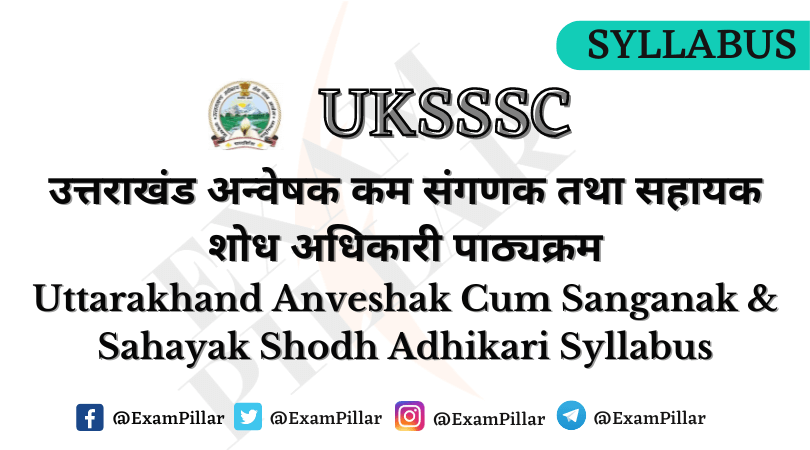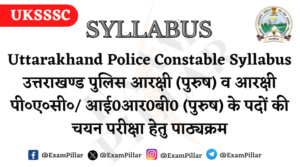UKSSSC Group ‘C’ अन्वेषक कम संगणक तथा सहायक शोध अधिकारी
अन्वेषक कम संगणक तथा सहायक शोध अधिकारी के पदों के पाठ्यक्रम के अन्तर्गत लिखित प्रतियोगी परीक्षा का प्रश्न पत्र कुल 100 अंकों का होगा। प्रश्न पत्र के दो भाग होंगें। प्रथम भाग (First Part ) Common Syllabus का है। Common Syllabus से आशय B.Sc / B.A. (सांख्यिकी / गणित) के साथ कम्प्यूटर संचालन हेतु प्राथमिक ज्ञान से है, यह भाग सभी अभ्यर्थियो के लिए अनिवार्य होंगा। इसमे 30 प्रतिशत प्रश्न कम्प्यूटर संचालन का प्राथमिक ज्ञान तथा गणित एवं सांख्यिकी का प्राथमिक एवं आधारभूत ज्ञान से सम्बन्धित प्रश्न पुछें जायेंगें तथा प्रश्न पत्र का दूसरा भाग (Second Part) सम्बन्धित विषयों – सांख्यिकी तथा गणित का पृथक – 2 होगा। इनमें प्रत्येक विषय के 70-70 प्रतिशत प्रश्न पुछें जायेंगें। अभ्यर्थी उक्त दोंनो विषयों में से किसी एक ही विषय का विकल्प ले सकता / चयन कर सकता है।
Common Syllabus (Part – I)
(30%)
MATHEMATICS
Types of matrices, addition and subtraction of matrices, multiplication of matrices, order and degree of differential equations, vectors and scalars, magnitude and direction of vectors, solution of quadratic and cubic equations, functions and relations, elementary differentiation and integration, direction ratios and direction cosines.
STATISTICS
Descriptive Statistics: Individual, Discrete and Continuous Data, Presentation of Data by Tables and Diagrams, Frequency Distributions, Graphical Representations of frequency Distributions, Measures of Central Tendency, Simple and Weighted Arithmetic Mean, Geometric Mean and Harmonic Mean, Median and Mode, and their Properties, Quartiles, Quintiles, Deciles and Percentiles, Contemporary Trends in Statistics.
FUNDAMENTALS OF COMPUTER
- Basic Concepts and terminologies related to Computer and Information Technology(IT).
- Basic Knowledge of various popular Operating Systems (Windows, Macintosh, Linux)
- Basic Knowledge of Major Mathematical, Statistical Data Processing Software’s.
- Functional knowledge of MS Office with all its applications such as MS Word, MS Excel, Power Point Presentation, MS Access and Notepad. Other major Presentation Software’s and Tools.
- Working with Internet: Basics of Computer Network and Internet, Internet Service Provider (ISP), Web Browsers, World Wide Web (WWW), URL and Domain Names. Uses of Internet, Concept of Search Engines, IP address, Application of Internet, Video- Conferencing, Using Email, Uploading and Downloading Files, Net Etiquettes and Ethics.
- Basic Knowledge of Computer Virus, Anti Virus Software’s, Cyber Security and IT related legal framework in India.
- Contemporary Issues and Recent Trends in Computer usage.
Syllabus Part II (Optional)
(70%)
(A) MATHEMATICS
(1) MATRICES : Types Of Matrices, Elementary Row And Column Operations, Inverse Of A Matrix, Rank Of Matrix, Eigen Values And Eigen Vectors, Characteristic Equations, System Of Equations, Consistency Of System Of Equations, Properties Of Determinants And Cramer’s Rule.
(2) TRIGONOMETRY : Trigonometric Functions, Trigonometric Equations, Inverse Trigonometric Functions, Exponential, Circular And Hyperbolic Functions, Logarithmic Functions, Gregory Series, Summation Of Trigonometric Series.
(3) VECTOR ANALYSIS : Differentiation And Integration Of Vectors, Differential Operators, Gradient, Divergence And Curl, Line Integral, Surface Integral, Volume Integral And Its Applications To Green Theorem, Gauss Divergence Theorem And Stokes Theorem.
(4) DIFFERENTIAL CALCULUS : Limit And Continuity, Differentiability Of Functions, Successive Differentiation, Leibnitz Theorem, Partial Differentiation, Euler’s Theorem On Homogeneous Functions, Tangent And Normal, Curvature, Rolle’s Theorem, Mean Value Theorems, Expansion Of Functions- Taylor’s Series And Maclaurin’s Series, Maxima And Minima, Indeterminate Forms.
(5) INTEGRAL CALCULUS : Definite Integral, Beta And Gamma Functions, Double Integral, Rectification (Length Of Curves).
(6) COORDINATE GEOMETRY : System Of Coordinates In Two And Three Dimensions, Direction Ratios And Direction Cosines, Plane And Straight Line, Cylinder, Cone And Sphere.
(7) ALGEBRA : Solution Of Quadratic, Cubic And Bi-Quadratic Equations With The Help Of Cardan’s, Descarte’s And Ferrari’s Methods, Group, Abelian Group, Order Of An Element Of A Group, Sub Group, Quotient Group, Normal Subgroup, Ring, Field, Ideal And Integral Domain.
(8) DIFFERENTIAL EQUATIONS : First Order Differential Equations( Including Boundary Value Problems)- Separable Variables, Homogeneous, Linear Differential Equations, Reducible To Linear Differential Equations, Exact Differential Equations, Equations Of First Order But Not Of First Degree, Orthogonal Trajectory, Linear Differential Equations With Constant Coefficients, Homogeneous Linear Equations, Simultaneous Differential Equations, Order And Degree Of Partial Differential Equations, Concept Of First Order Partial Differential Equations.
(9) REAL ANALYSIS : Completeness Of Real Numbers, Countability Of Sets, Open And Closed Sets, Sequence And Series: Ratio’s Test, Rabee’s Test, Cauchy Root Test, Logarithmic Test, De Morgans Test.
(10) COMPLEX ANALYSIS : Modulus and Argument of a complex number and their properties, Analytic Functions, Complex Integration, Cauchy Theorem, Cauchy Integral Formula, Taylor’s Theorem, Singularities And Poles.
(11) LINEAR ALGEBRA : Vector Space And Subspace, Quotient Space, Linear Combination Of Vectors, Linear Dependence And Independence Of Vectors, Linear Span, Basis And Dimensions, Linear Transformations.
(12) NUMERICAL ANALYSIS : Finite Differences, Difference Operators, Newton’s Interpolation, Divided Differences, Interpolation With Unequal Intervals, Numerical Differentiation And Numerical Integration, Newton’s Cote’s Formula, Trapezoidal’s Rule, Simpson 1/3 Rule, Simpson’s 3/8 Rule.
(13) LINEAR PROGRAMMING PROBLEM: General Linear Programming Problem, Graphical Method, Simplex Method, Basic Solution Of Linear Programming Problem.
Syllabus Part II (Optional)
(70%)
(B) STATISTICS
(1) MEASURES OF DISPERSION: Range, Quartile Deviation, Mean Deviation, Standard Deviation And Their Properties, Co-Efficient Of Variation, Moments, Skewness, Kurtosis.
(2) STATISTICAL METHODS: CORRELATION: Introduction, meaning of correlation, Karl Pearson’s coefficient of correlation, limits for correlation coefficient, assumptions underlying Karl Pearson’s correlation coefficient, Rank Correlation- Spearman’s rank correlation coefficient, tied or repeated ranks.
REGRESSION: Introduction, linear regression, obtaining lines of regression, regression coefficients, properties of regression coefficients, angle between two lines of regression
(3) PROBABILITY THEORY: Basic terminology, random experiment, trial, sample point, sample space, definitions of equally- likely, mutually- exclusive and exhaustive events, independent and dependent events. Theorems on probability: addition theorem of probability, extension of addition theorem of probability to n events, Boole’s inequality, conditional probability, multiplication theory of probability, probability of occurrence of at least one of the events. Bayes’ theorem
RANDOM VARIABLES: Discrete and continuous, probability mass function (pmf) and probability density function (pdf), cumulative distribution function (cdf). Distribution function, joint distribution of two random variables, marginal and conditional distributions, independence of random variables.
EXPECTATION: Theorem on expectation of sum of random variables and product of independent random variables, conditional expectation, moments, moment generating function (m.g.f.).
(4) PROBABILITY DISTRIBUTIONS: Univariate distributions: Discrete-Bernoulli, Binomial, Poisson, Hypergeometric, Negative Binomial, fitting of Binomial and Poisson distributions. Continuous univariate distributions: Uniform, Normal, Exponential Distributions with properties and its fitting.
EXACT SAMPLING DISTRIBUTIONS: Chi-Square x2 Distribution: Introduction, Derivation of the chi-square distribution, M.G.F. of Chi- Square Distribution, Cumulant generating function of x2 – distribution, Additive Property of x2 – variates. STUDENT’S ‘t’ DISTRIBUTION- Derivation of Student’s t-Distribution, Fisher’s ‘t’, Distribution of Fisher’s ‘t’, Constants of t-Distribution, Critical values of t. F- distribution- derivation of Snedecor’s F-distribution, constants of F- distribution, mode and points of inflexion of F distribution, relation between t and F distributions, relation between F and x2 distributions.
(5) APPLIED STATISTICS: Statistical quality control, process and product control, general theory of control charts, different types of control charts for variables and attributes. Sampling inspection by attributes-single and double sampling plans, producer’s and consumer’s risk, OC, ASN, AOQL and LTPD of sampling plans.
TIME-SERIES: Its different components and Methods for their Measurement, Additive and Multiplicative Models.
VITAL STATISTICS: Measurement of mortality, crude death rates, age specific death rates, infant mortality rates, death rate by cause. Measurement of fertility-crude birth rate, general fertility rate, age- specific birth rate, total fertility rate, gross reproduction rate, net reproduction rate, standardized death rates. Complete life table, its main features and construction.
(6) SAMPLE SURVEY AND ANALYSIS AND DESIGN OF EXPERIMENTS:
SAMPLING METHOD: concept of population, sample, parameter and statistic, sampling vs. Complete enumeration, sampling units and frame. Advantages of sampling methods, role of sampling theory, sampling and non-sampling errors, bias and its effects, probability sampling, Simple random sampling with and without replacement. STRATIFIED RANDOM SAMPLING: Principles of Stratification, Advantages and uses of Stratified Sampling, Allocation of Sample Size- Equal Allocation Proportional Allocation, Neyman Optimum Allocation (Without Cost Function), Variance of the Estimates in the above Cases, Systematic Sampling.
ANALYSIS OF VARIANCE: The linear models for one way and two way classification, least square method of obtaining sum of squares. Principles of design of experiments-replication randomization and local control and their importance in design theory, completely randomized design- layout, statistical analysis and efficiency comparisons with other designs, randomized block design-layout, statistical analysis and efficiency comparisons with other designs and latin square design- layout, statistical analysis and efficiency
(7) STATISTICAL INFERENCE : Estimators and estimate, characteristics of estimators-unbiasedness, consistency, efficiency, sufficiency. Statistical hypothesis-simple and composite hypothesis, test of a statistical hypothesis, null hypothesis, alternative hypothesis, critical region, two types of error, level of significance, power of the test.
| Download UKSSSC Anveshak Cum Sanganak & Sahayak Shodh Adhikari (अन्वेषक कम संगणक तथा सहायक शोध अधिकारी) Syllabus in PDF |
| Read Also : |
|
|---|---|
| UKSSSC G. B. Pant University Assistant Accountant Exam – 29 Nov 2020 (Official Answer Key) |
Click Here |
| UKSSSC Assistant Accountant Exam Paper 13 May 2018 (Official Answer Key) | Click Here |
| UKSSSC Assistant Accountant Exam 19 May 2019 (Answer Key) | Click Here |










